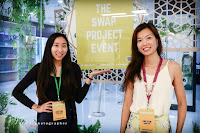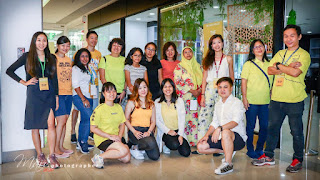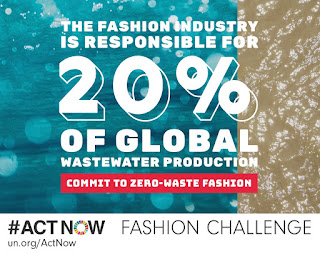The Swap Project (TSP, 2020 Edition)

Hand-Me-Downs. Pre-Loved Clothes. You are probably familiar with the family tradition of wearing hand me downs from an older relative. Most of the time, they were good quality clothing, in wearable condition and still presentable. There was no negative feeling about it, and sometimes, seeing the look of nostalgia on relatives seeing you putting it on for the first time gave up a very warm feeling, so you never questioned the practise.
I remember growing up with a lot of older cousins and many uncles. Thus wearing hand me downs was a common thing, especially since I was the privileged sort who grew up in the city, on the farm and in the wild at the same time. I even remember having fun wearing bell bottoms and tripping all over the place on a date! My date thought it was cute and funny. But imagine doing that today, and with other people's pre-loved clothing?
According to the National Solid Waste Management Department of Malaysia, approximately 200,000 tonnes of Textile Waste ended up in Malaysian landfills. This is a staggering amount of clothing and fabric being thrown away, I hazard a guess that it is enough to build a block of skyscrapers to grace the cityline of Kuala Lumpur. And here is a troubling thought, what happens when all the clothing that we have been busy giving away to charities do not end up being distributed or worn? Where do all these go? I reckon we need more initiatives to handle the problem of recycling textile waste, but in the meantime, a pair of women came up with an innovative solution.
Meet Ms. Jamie Choy and Ms. Jayda Chong, founders of the Swap Project. Their objective, to try and combat Textile Waste by increasing the lifespan of clothing through communal exchange. By increasing the lifespan of clothing, participating owners get the chance to own a new look without having to buy new items. It is very friendly to the environment as it prevents the throwing away of wearable clothing and curbs the constant need to constantly buy new clothing. Jayda calls this slow fashion, which is the opposite of fast fashion, and this in turn supports textile sustainability. But this is not limited to just clothing, items exchanged also includes shoes, bags, jewellery and fashion accessories. And strictly No Undergarments. You might want to try selling that to "niche collectors" though.
How The Swap Collection Was Born And Took Life
Sometime in November 2018, Jamie found herself saying good riddance goodbye to two good friends who were migrating away. They left behind a legacy of friendship... and about 50kgs worth of clothing. Their fate, a recycling center. So it was that late one evening, she drove over to their respective place to pick up the clothes and assess their condition. Some of it were worn once or twice before, the rest of the lot were actually brand new, with the price tags still on even. The collection was in very good condition, and obviously meant for a better fate other than a recycling centre.
She took the entire collection to her soho at Empire Damansara, sat down, and looked at the piles of neatly folded and packed clothing. There was just too much to hoard keep and she knew she had to give them away as promised. Feeling a bit overwhelmed, she called her good friend Jayda over and together, they hatched a plan to launch a small project to find suitable homes for the collection. They decided to call it The Swap Project (TSP).
The first TSP event was held on the 18 November 2018, from 2pm to 4pm, at Jamie’s home. But despite some shout out on social media and the creation of an event landing page on Facebook, nobody came. NOBODY. Nonplussed, they dutifully waited the whole 2 hours before closing shop, and then went to a mall for some much needed food therapy. What had gone wrong?
They did not know either but thankfully, did not give up. They decided to host another event again, and this time, 10 persons showed up. They managed to distribute some 30 kgs of clothing but somehow, they managed to accumulate 60 kgs more of clothing in return. And ever since that day, for every TSP event thus far, Jaime says that they have been accumulating twice as much textile compared to what was taken away by new owners.
Last weekend I attended event no. 11. They have accumulated approximately 300 kgs so far. And it turned out to be the best session for TSP, about 200 persons showed up to swap clothing, most of them women. There was one table exclusively for men as well, I found myself a nice singlet for working out.
How Does It Work?
If you are wondering, the TSP has a few easy to follow guidelines. I looked it up and copied directly from their events page:
- Bring a minimum of 5 pieces of clothes that are clean and still in good condition (tops, bottoms, dresses, menswear, bags, jewellery, shoes).
- Register at the Registration Counter and pay MYR20.
- Pass your clothes to our friendly volunteers at the Drop-off Counter.
- Go ahead and SWAP! You can swap as many pieces as you like... as long as you promise to use them!
Hopes and Challenges
From my short interview with Jamie and Jayda, I learned that they have a pool of about 50 volunteers. Although this is sufficient for now, they would like to expand this project nationwide and work on raising awareness about textile sustainability. To this end, they are looking for people and organisations who are open to collaboration and or partnerships in order to increase their capacity to host more activities. If you would like to contribute your time or ideas, or are generally interested to see how you can help with this project, you can FB Message them directly.
To find out more about their next exchange event, you can follow their Facebook Page which is kept updated of their current doings. If you would like to see more pictures from last weekend, you can view the album here.
*****
What is Textile Waste? In a nutshell, it is material that is no longer considered usable for it's intended purpose. during clothing production, excess fibre and textile that do not measure up are discarded and thrown away. Consumers who buy these clothing will eventually feel the need to throw these items away, most of which may be deemed unwearable because it has gone out of fashion or it has grown mold, old or torn. All these are considered textile waste, and millions of tons of it are filling up landfills all over the world. If you would like to learn more about this and how we as individuals can act to change this on our part, here are some helpful links:
*****
Everydayfoodilove.co/ angeline-ong-yoga.blogspot.com. Thank you for reading our posts. Our team media coverage touches mostly on lifestyle events and focuses on happening scenes in Kuala Lumpur and Kota Kinabalu. Invite us for food reviews, travel and hotel reviews, KL clubbing reviews and product launches. Our other interests include the movies, technology and photography. Subscribe to my facebook page. Contact us via my email at: [email protected] or [email protected]
Instagram: @angelineonglimin ASEAN TOP 50 SOCIAL MEDIA INFLUENCERS AWARD 2019 at ASEAN OUTSTANDING BUSINESS AWARD 2019 #AOBA #ARFF

















Comments